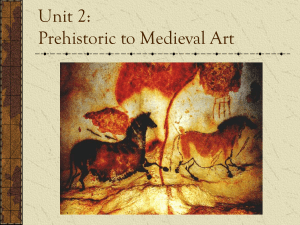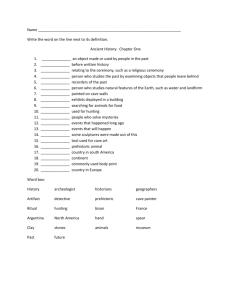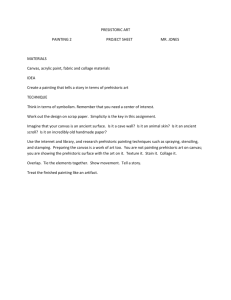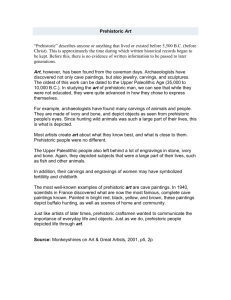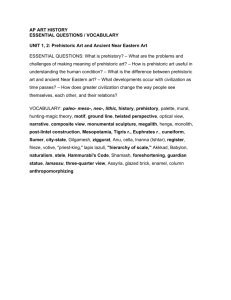ap art history - Doral Academy Preparatory
advertisement
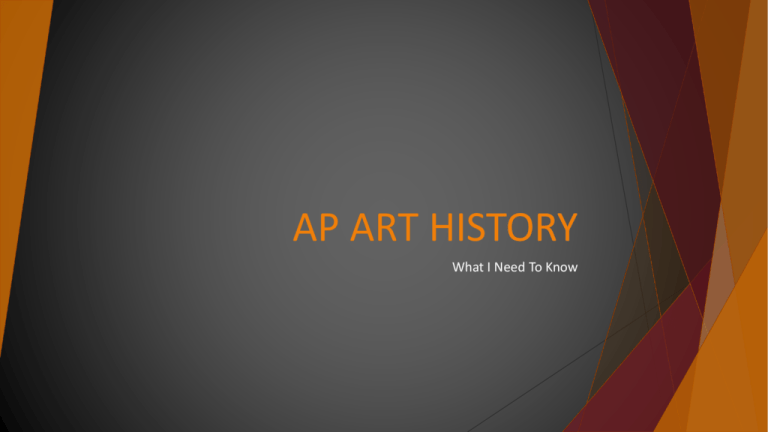
AP ART HISTORY What I Need To Know ELEMENTS OF ART AND PRINCIPLES OF DESIGN ART ELEMENTS Line – A point in motion , continuous outline (contour line) Shape- Line that encloses a space Texture- The literal or visual illusion of how a surface feels. Can be used to create value in replacement of shading, can create patter/ rhythm Value- The darkness or lightness of a hue Form- third dimensional rendition of a shape, can be created with the use of value Space- The area around and between an object…Positive takes up space / negative does not Color- Light reflected or emitted from an object to the eye. Intensity or saturation, Tint and shade, cool (blue, green, violet) and warm (red,orange,yellow) Elements in Depth Line can be suggested or implied by edges of planes or juxtaposition. Implied line. Line can also guide the eye through an art work. Decorative Shape can be repeated or varied to create visual texture, negative/positive space shapes. Delicate understanding of materials can lead to realistic execution of visual surface texture. Form as element differs from ART FORM which refers to the type of art. Every color has a large range of possible values…depending on the lighting situation even yellow can be darker in value than “black”. Values can create a visual push and pull. Color is the most complex. Colors can convey an emotion, manipulate the viewer etc. Space is used by many masters in order to convey a desired emotion or visual stability or lack thereof. Perspective and foreshortening can create the illusion of depth Materials, Media and Process Drawing • Pencil- graphite • Charcoal • Ink • Quill and pen • Brush drawing • Oil pastels • Soft pastels Painting • Acrylic • Watercolor and Gouache • Ink painting • Oils • Oil pastels • Pigment and hot wax Encaustic • Frescoes • Tempera • Spray paint Graphic arts • Mesopotamian – picture symbols, Egyptian Hieroglyphics • Typography- printed letters • Logos • • • • Digital design Illustration Layout design Web design Printmaking (limited editions) Relief- carving away non printing Intaglio- thin cut into metal or Plexiglas for printing Planography- lithography- on stone and silkscreen (non reverse) Monotypes and monoprintsoriginal is copy Photography Film Performance art Digital Art Installation 3D Readymades- Appropriation artist taking over pre-existing image Changing meaning or purpose Architecture Post- and-lintel Hypostyle hall Corbeled arch Aqueduct Principles of Design Balance- The distribution of Art Elements to create an even visual weight. Rhythm- Created through the use of repeated art elements, Visual flow. Repetition- To reuse a certain image or element various times through out a work of art. Movement- Using art elements to make the eye move throughout the work. How the eye moves. Pattern- arrangement of repeated or alternated elements of art. Emphasis (Focal Point)- The use of art elements to create a sense of visual importance to a given object or area in a work of art. Juxtaposition, location, size, color…. Variety- Alternating the use of certain art elements to maintain visual interest. Proportion or scale- The relationship between objects with relation to their size, number… Unity- Visual harmony, where all parts of the work are working together to create aesthetics. HOW TO CRITIQUE ART Art Criticism Steps Describe- What do you see. What materials were used, what elements, principles of design, size of work, art style and genre. NO OPINIONS Formal analysis- Explore the use of the Principles of Design and provide examples of use. Interpretation- Meaning or message (what is the artist saying) in the work. Provide evidence. Judgement- Evaluation of work, is it of good quality and successful? Why? How does it compare to other similar works. Provide supporting evidence. WHAT I NEED TO KNOW HOW TO DO Differentiate components of form, function, content and/ or context of a work of art. BREAKDOWN Form- The scheme followed in shaping an artistic work. Content- subject matter . The circumstances that form the setting for an event statement or idea and in terms of which it can be fully understood. Function- The purpose or activity for which a work of art exists or is used. Continued Identification- Being able to assign a work of art or distinguish it from a given period or artist Formal Analysis- Close inspection of an artists use of Art Elements ( same as in critique) Stylistic analysis- Design element similarities which may resemble a certain artistic approach, manner or period. Some quality must be shared by every member of the group. (personal, due to environment, resources available, time or event) Contextual analysis- Similar to observation of formal elements on visual characteristics but w/ the addition of deeper research in attempt to connect the works formal achievements to Historical, religious, cultural purposes and meaning. Questions to ask…..Formal analysis, who made it, when and where, Patronage, and or social purpose, cultural meaning/ significance. Thinking Conceptually (Art as a metaphor)- How do some works suggest or promote large ideas other than the visual themes? Interpreting Iconography- Images or symbolisms used in a work and its possible interpretations. Artist intention/ meaning of the work- Why, how, where, when was the work created ? Synthesizing different ideas- on visual objects (compare – similarities and differences/ ContrastHow different when looked at juxtaposed to the other. Techniques and History of making art Intro to Work Through Critique Process HOMELEARNING ASSIGNMENT Statues of votive figures, from the Square Temple at Eshnunna. (Modern Tell Asmar, Iraq) Sumerian c. 2700 B.C.E Gypsum inlaid with shell and black limestone. San Vital, Justinian Panel. Ravenna, Italy. Early Byzantine Europe. C. 526-547 C.E. Brick, marble, and stone veneer; mosaic Les Demoiselles d'Avignon. Pablo Picasso Museum of Modern Art Cubism 1907 – Oil paint GLOBAL PREHISTORY PREHISTORIC ART PALEOLITHIC ART 30,000 B.C.E- 8000 B.C.E in the Near East; later in the rest of the world Neolithic Art 8,000 B.C.E- 3000 B.C.E. in the Near East ; later in the rest of the world Visual Examples Drawing in Prehistoric Art Fun fact: Cave was named after Apollo moon landing found during same time. Hist. Wonderwerk Cave in Nambian, Africa some of the oldest works found. Work was portable Theme? The species are uncertain Animal Facing Left, Apollo 11 Stones. The Charcoal used in the animal facing left stone Namibia. c. 25,500-25,300 B.C.E dates around 23,000 B.C.E Charcoal on stone Subject was always animals in Paleolithic How ? Prehistoric depiction of animal always in profile Visual Examples Painting in Prehistoric Art Great Hall of the Bulls. Lascaux, France. Paleolithic Europe. 15,000-13000 B.C.E Rock Painting Cultural comparisons - Tomb of the Triclinium - Leonardo DaVinci Last Supper - Walker, Darkytown Rebellion How? -Paint made from natural products, charcoal, iron ore, plants -Some figures overlap -Scaffolding evidence to reach higher areas of cave. -walls were scrapped to even surface -paint bound and lamps with animal fat -Flat stones used as palettes What? -650 paintings of- cows horses bulls and deer Where? -Hundreds of feet from entrance of cave Profile, Frontal and diagonal view of horns eyes and hooves- some appear pregnant. -Caves not dwelling – nomads follow animals (some evidence of mouth of cave used as shelter) Why? -Used to ensure successful hunt -Ancestral animal worship -Shamanism- shamans (contact forces of nature through trance) CLASS ASSIGNMENT CAVE IS WHERE THE ART IS (start drawing once you finish reading) This week be bad…no animal…me hungry… me need food. I need idea..better. I hunt. I plan. I think. Animal be big. I want….many animal. Please I need……..my family need. We all hungry. I draw. I get animal…… Cross- Cultural connection/ comparison Tomb of the Triclinium, C. 480-470 B.C.E., Tufa and Frescoe, Tarquinia, Italy Fun Fact: -Named after an ancient Roman dining table, which appears in the fresco What? - (couples) Ancient manner of eating in reclined pose - Rural setting by depicting trees and shrubbery - Possible funeral banquet, emotion is celebration of dead - Circles may represent time on checkerboard ceiling How? -Ancient convention of painting men in darker color than women Where? Italy, Etruscan funerary paintings about 280 still exstant (could be of Greek influence..but due to less Greek paintings left hard to prove. Cross-cultural cont. Kara, Walker, Darkytown Rebellion, 2001, cut paper and projection on wall, Collection Musee d’Art Moderne GrandDuc Jean, Luxembourg How? Technique -Draws images w/ greasy white pencil or soft pastel crayon on large pieces of black paper; cuts paper w/ knife Images stick on wall w/ wax Traditional silhouette forms Overhead projector throws light Peoples shadow mingle with work People become part of the piece What? Exploration of African American in the antebellum south (South Carolina period between the War of 1812, and the American Civil War, ) Teenager holds flag resembling colonial ship sail man has his leg cut off woman having abortion another woman cares for newboen Cross-cultural cont. Depicts great moment of moment when Jesus says “one of you will betray me” (Matthew 26:21) Leonardo da Vinci, The last Supper, 1494-1498, Tempera and oil, Santa Maria delle Grazie, Milan Who? Commissioned by Sforza of Milan for the refectory or dining hall of a Dominican abbey What? Relationship between the friars eating and a Biblical meal How? Oil and tempera, to attempt greater chiaroscuro but paint started to peel off in Leo’s lifetime Many restorations Apostles grouped in three and three windows symbolizing the Trinity Where? On a wall, only work of Leonardo da Vinci that remains in situ Running Horned Woman 6,000-4000 B.C.E rock painting, Tassili n’Ajjer, Algeria Aka elephant mask, c. nineteenth to twentieth century, wood, woven raffia, cloth, and beads Where? -Algeria, more than 15,000 drawings and engravings found at this site. -At one time the area was grass lands; climate changes have turned it into desert How? Some drawings are naturalistic some abstract and some Negroid features some Caucasian features Depicts live stock cows sheep wildlife giraffes lions humans hunting harvesting Composite view of the body Dots may reflects body paint applied for ritual The entire site was probably painted by many different groups over a large expanse of time Visual example Sculpture in Prehistoric Art Camelid sacrum in the shape of a canine, 14,000- 7,000 B.C.E ., bone, National Museum of Anthropology, Mexico Where? -From Tequixquiac, Mexico -Bone sculpture from a camel- like animal -Sacrum is the triangular bone at the base of the spine How? -Bone has been worked to create the image of a dog or wolf -One natural form used to take the shape of another -Carved to represent a mammal’s skull -Mesoamerican idea that a sacrum is a “second skull” When? Found in 1870 Visual example Anthropomorphic stele, fourth millennium B.C.E., sandstone Pergamon Museum, Berlin Sculpture in Prehistoric Art When? -One of the earliest known works of art from Arabia Where? -Found in an area that had extensive ancient trade roots Why? -Religious or burial purpose What? -Belted robe from which hangs a double bladed knife or sword -Anthropomorphic resembles human form but not in itself human Visual example Beaker with ibex motifs. Susa, Iran 4200-3500 B.C.E. painted terra cotta Where? Sculpture in Prehistoric Art -Found near burial site, but not with human remains -Made in Susa, in Southwestern Iran -Found with hundreds of baskets, bowls, and metallic items How? -Use of potter’s wheel, a technological advance -Thin walls of pot What? -Frieze of stylized aquatic birds on top ; below stylized running dogs with long narrow bodies -Oversized horns abstract stylized motif -In the middle of horns is a clan symbol of family ownership Why? -Perhaps the image identifies the deceased as belonging to a particular group or family Tlatilco Female Figures c. 1200900 B.C.E, ceramic, Princeton University Art Museum, Princeton, New Jersey Where? Tlatilco, Mexico, noted for pottery What? Many shapes and forms: male, female, couples, etc. Female figures show elaborate details of hair styles, clothing, and body ornaments Many show deformities including twoheaded females: possible signification of a cluster of conjoined or Siamese twins; stillborn Theories that they show bifacial images, and therefore would show the first evidence of congenital defects May have had shamanistic function Style:flipper-like arms; huge thighs, pronounced hips, narrow waists, unclothed except for jewelry; arms extend from the body terra-cotta fragment. lapita, from the solomon islands, Art Movements Surrealism Cubism Realism Abstract Impressionism Expressionism Modern Post modern Abstract expressionism Dada Op Art Futurism Deconstructivism Minimalism Mannerism Political Art Periods


